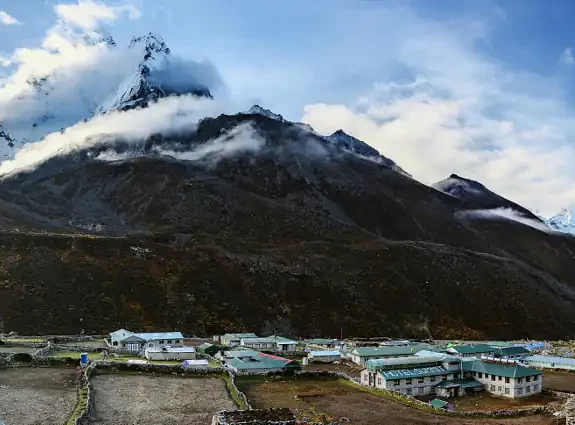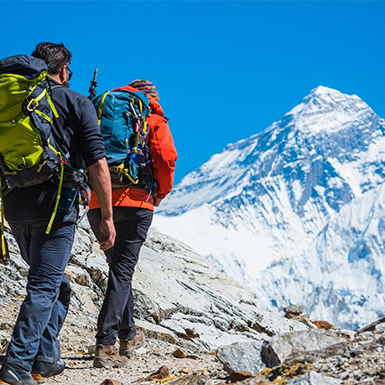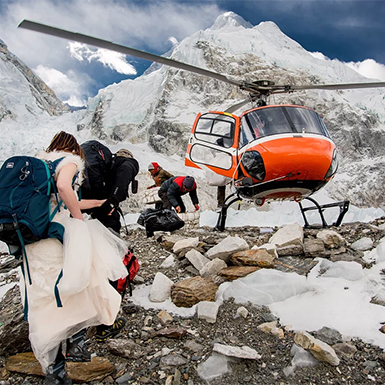Lobuche Village is an eponymous settlement near the Khumbu Glacier in the Solukhumbu district of Eastern Nepal. It is one of the last points before arriving at Everest Base Camp and Kalapatthar, passing through Gorakshep village.
It is one of the most beautiful towns in Nepal, famous for its panorama and vastness. It rises to an altitude of 4,940m and comprises small lodges where you can stay overnight.
The Lobuche Village takes its name from the two nearby modest-sized peaks, Lobuche East and Lobuche West, 6119 m and 6145 m, respectively. About a 30-minute walk takes you to the Pyramid—a glass structure managed entirely by Italians. It is a research center where the researchers monitor all mountain data (pressure, climate change, etc.). All facilities are equipped with oxygen to prevent altitude sickness and an internet connection upon purchase of a particular card.
Expediting in Lobuche allows you to walk under one of the most beautiful mountain landscapes in the world. You will have the chance to mix with the Sherpas, a legendary ethnic group known for their physical strength and hospitality.
The high season to visit settlements like Lobuche is April and May when the village welcomes the spring season, and September to November when autumn greets the settlement.
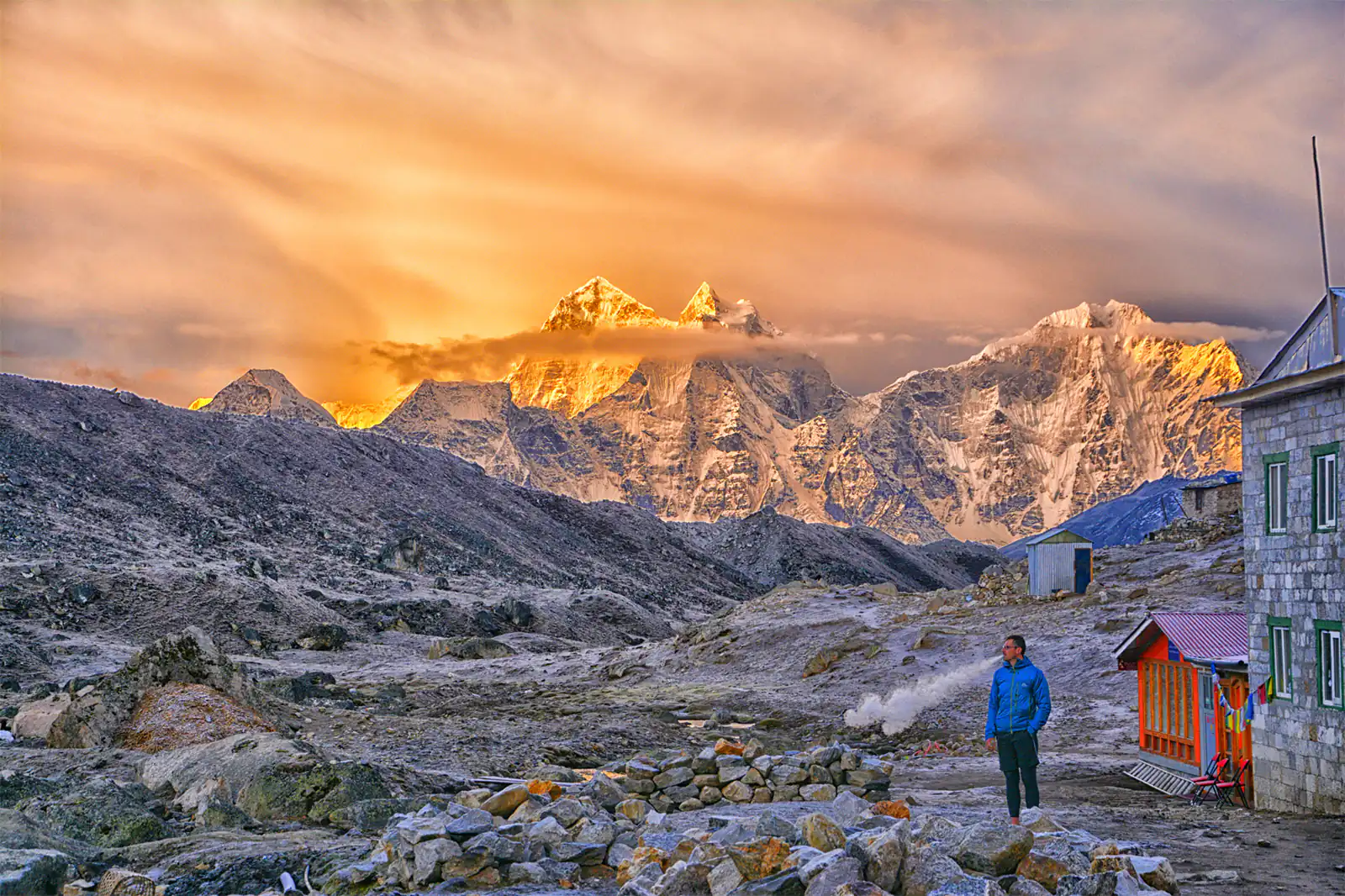
Attractions of Lobuche Village
Lobuche Village, isolated from the world, needs no special effort to seduce its guests. Most often, trekkers arriving in the village to climb Lobuche Peak or go to the Everest Base camp are mesmerized by the beautiful view of all the surrounding mountains, including Mount Everest, Lhotse, Nuptse, Pumori, Ama Dablam, and many more.
A leisurely walk around the town allows you to pass the Sherpa dwellings with prayer wheels and breathtaking views of numerous glaciers and deep valleys of the Khumbu region that will surely not be soon forgotten.
Accommodation in Lobuche Village
Lobuche mainly depends on tourism. Sherpa men work as porters or guides; some residents have turned their huts into small lodges or guest houses. You can pay for the lodge directly at the village entrance, choose one of the structures that best suits you, and spend the night.
If desired, there is the possibility of staying overnight in a tent in a space made available by the village without incurring further costs. All the lodges have a restaurant where you can drink and eat at reasonable prices.
Dingboche/Pheriche to Lobuche Village
Lobuche is 12 km from Dingboche, a small Sherpa village on the way to Everest Base Camp. It takes about 5 hours to reach Lobuche with a leisurely walk. The passage between the two villages gives access to the Makalu region and the Mera Peak.
The path runs on a level curve, a moraine, and you can see the Lobuche peak close to the horizon. A short walk and the Khumbu spread out at your feet with its string of icy peaks. Further on, Pumori and Nuptse await your visit. Soon, you will discover the hamlet of Lobuche at the turn of a retreat from the field.
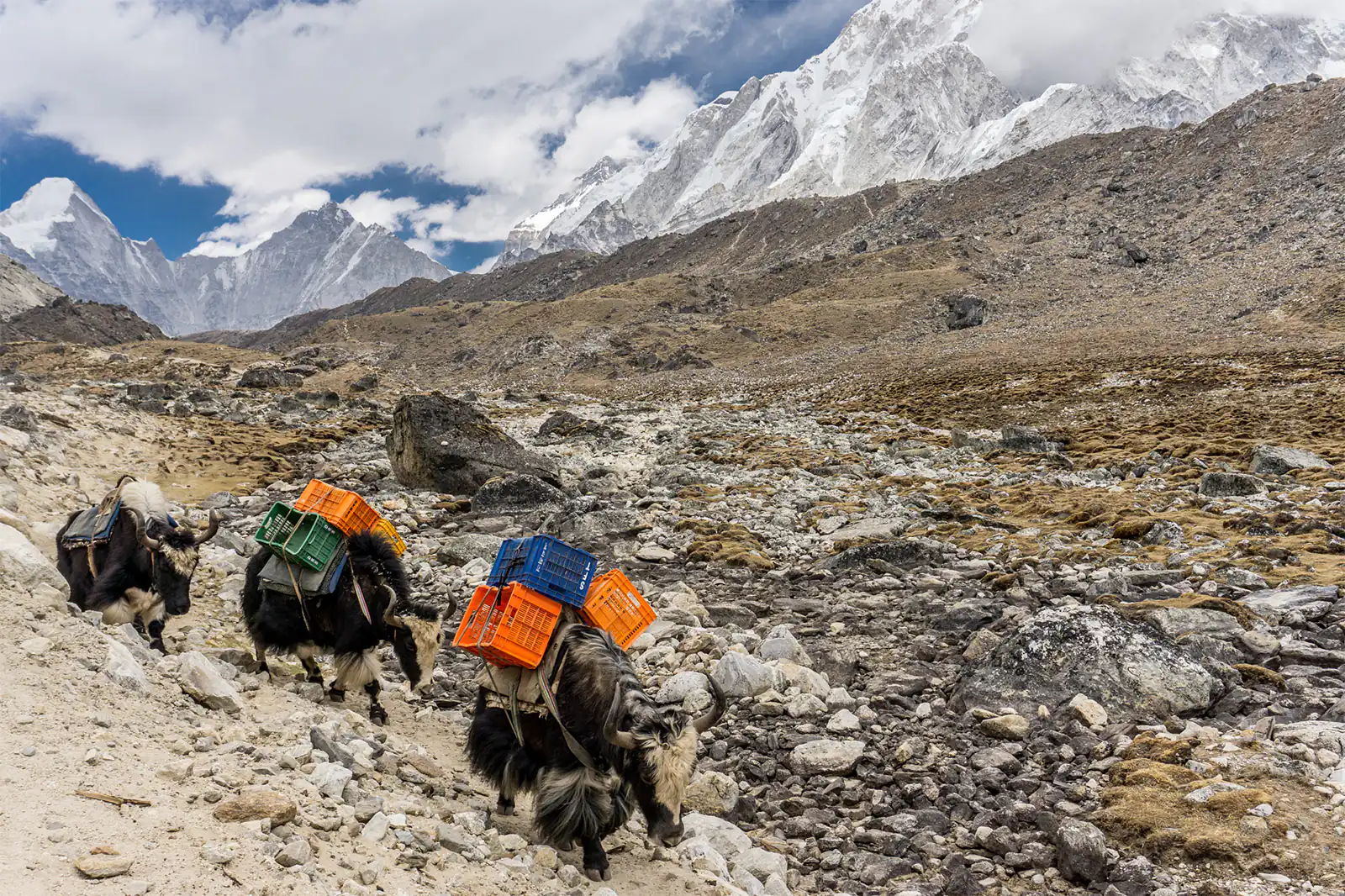
Lobuche to Gorakshep and Everest Base Camp
The distance between Lobuche Village and Everest base camp is 15 km, which you can cover in about 8 hours. As you begin your hike from Lobuche, within approximately 3 or 4 hours, you will reach the last settlement on the trail- Gorakshep. Several tea houses in this area provide overnight accommodation before making the last leg of the trek over the glacier to Everest Base Camp.
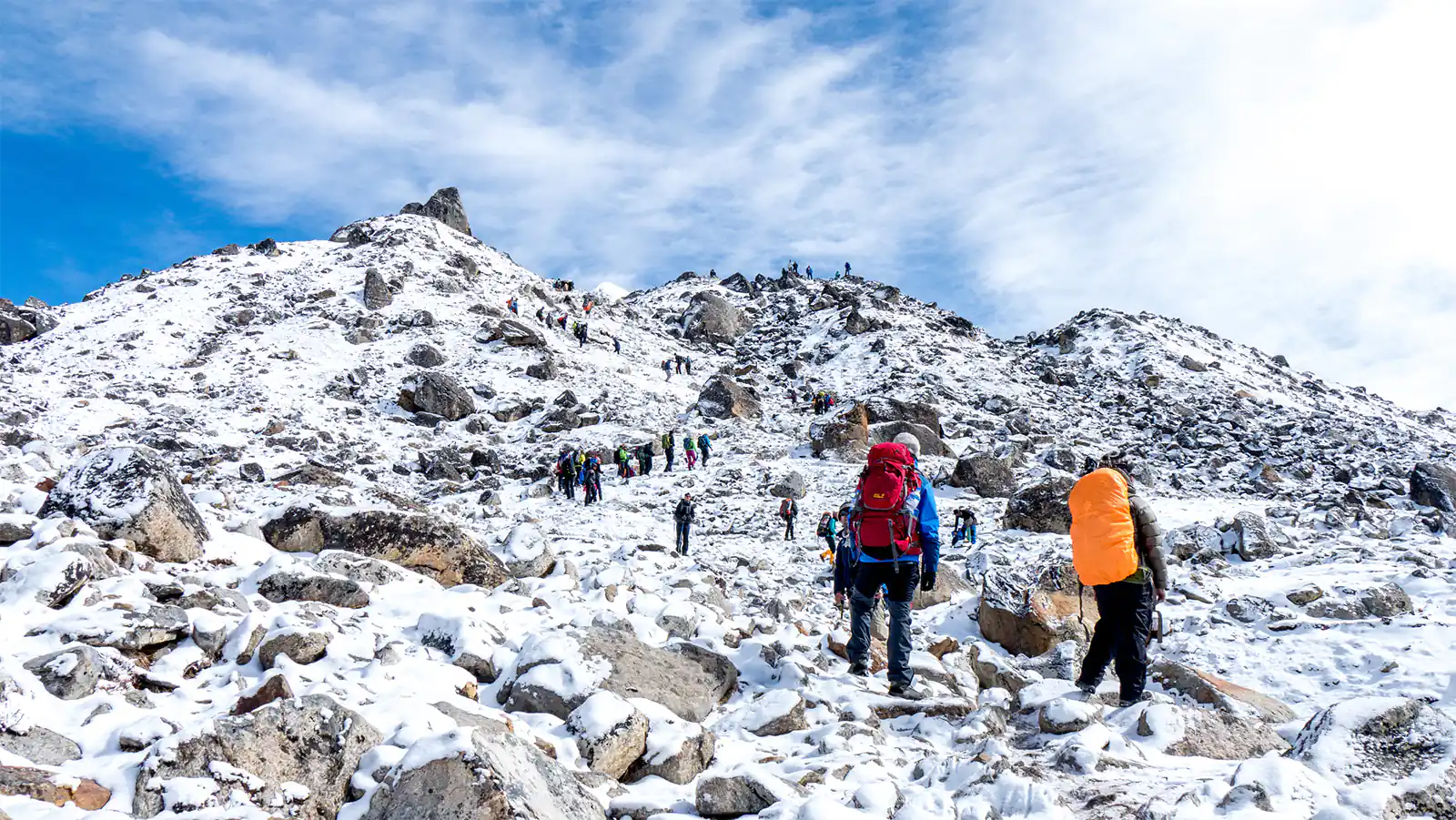
Above Gorakshep, you can see the popular viewpoint known as Kala Patthar, where many travelers capture the image of the world’s highest mountain and gaze at it in awe. The hike from the glacier to the base camp can take up to five hours. This is a treacherous section, and you must navigate it carefully. It can be challenging to find a route, and the risk of falling on the ice is high.
A mere 2-hour hike from Gorakshep, and you are at the base camp. Around 2,000 people can be seen gathering here during the spring season. Climbers rest here for 5 to 6 days, and the climbing journey begins.

A Gateway to the World’s Highest Peaks
Lobuche Village is crucial to the popular trekking routes in the Khumbu region. It is one of the last settlements before reaching Everest Base Camp, making it an essential acclimatization spot for climbers and trekkers. The village also serves as a starting point for expeditions to Lobuche East and Lobuche West peaks, popular among mountaineers seeking challenging climbs with rewarding views.
Cultural Crossroads
As part of the Solukhumbu district, Lobuche is home to the Sherpa community, renowned for their mountaineering skills and warm hospitality. The village is a cultural hub where visitors can learn about Sherpa traditions, Buddhism, and the unique way of life adapted to high-altitude living.
Geography and Climate
Stunning Himalayan Landscape
Surrounded by towering peaks such as Mount Everest, Lhotse, Nuptse, and Ama Dablam, Lobuche offers breathtaking panoramic views. The village lies near the Khumbu Glacier, one of the largest glaciers in Nepal, adding to the dramatic scenery of ice formations and rugged terrain.
High-Altitude Climate
The weather in Lobuche is typical of high-altitude Himalayan environments. Temperatures vary significantly between day and night, often dropping below freezing after sunset. The best times to visit are during the pre-monsoon (March to May) and post-monsoon (September to November) seasons when the skies are clear and the weather is relatively stable.
The Local Community and Culture
Sherpa Traditions
The Sherpa people of Lobuche are deeply rooted in Tibetan Buddhism. Visitors can observe traditional prayer flags fluttering in the wind, mani stones carved with sacred mantras, and shortens (stupas) that reflect the area’s spiritual significance. Interacting with the locals provides insight into their resilience, spirituality, and close relationship with the mountains.
Festivals and Celebrations
While Lobuche is a small village, it participates in regional festivals such as Mani Rimdu and Losar (Tibetan New Year). These events are marked by colorful dances, music, and rituals performed by monks and villagers, offering a vibrant glimpse into Sherpa’s cultural heritage.
Trekking Routes and Activities
Popular Trekking Destination
Apart from being a stopover for Everest Base Camp trekkers, Lobuche is a destination in its own right. Trekkers can explore less-traveled paths leading to high-altitude lakes, glaciers, and lesser-known peaks. The village is also part of the challenging Three Passes Trek, which includes crossing Kongma La Pass (5,535 meters), offering stunning views and an adventurous experience.
Climbing Lobuche Peaks
Lobuche East Peak (6,119 meters) and Lobuche West Peak (6,145 meters) present exciting climbing opportunities for mountaineers. While these peaks are considered more accessible than Everest, they still require technical climbing skills and acclimatization, making them suitable for experienced climbers seeking to test their abilities.
Flora and Fauna
Alpine Biodiversity
The harsh climatic conditions around Lobuche support unique flora and fauna adapted to high altitudes. Trekkers might spot hardy plants like dwarf rhododendrons, mosses, and lichens clinging to rocky surfaces. In the spring, pockets of wildflowers add splashes of color to the landscape.
Wildlife Encounters
Wildlife sightings may include Himalayan tahr (a wild goat), musk deer, and various bird species such as the Himalayan monal, Nepal’s national bird. While rare, some trekkers have reported glimpses of the elusive snow leopard or signs of their presence.
Challenges of High-Altitude Living
Altitude Sickness Awareness
At nearly 5,000 meters, Lobuche poses acute mountain sickness (AMS) risks for visitors who ascend too quickly without proper acclimatization. Symptoms include headaches, nausea, dizziness, and fatigue. Trekkers must ascend gradually, stay hydrated, and allow time for their bodies to adjust.
Limited Resources
Due to its remote location, Lobuche has limited access to resources like fresh produce, fuel, and medical facilities. Electricity is often solar-powered, and communication networks may be unreliable. Visitors should be prepared for primary living conditions and carry essential supplies.
Safety Tips for Visitors
Preparation and Acclimatization
- Gradual Ascent: Follow a trekking itinerary that allows for acclimatization days.
- Hydration and Nutrition: Drink plenty of water and eat energy-rich foods.
- Listen to Your Body: Pay attention to symptoms of AMS and inform your guide if you feel unwell.
Hiring Experienced Guides
Engaging local Sherpa guides and porters enhances safety and enriches the trekking experience. Local guides offer expertise on the terrain and culture and can assist in emergencies.
Environmental Responsibility
- Leave No Trace: Carry out all non-biodegradable waste.
- Use Eco-Friendly Products: Avoid plastic bottles; use water purification methods.
- Respect Wildlife: Observe animals from a distance without disturbing their natural behavior.
Additional Information
How to Get to Lobuche
- Starting Point: Most Lobuche treks start with a flight to Lukla Airport.
- Trekking Route: The typical route passes through villages like Namche Bazaar, Tengboche, and Dingboche and then goes to Lobuche.
- Duration: It takes about 8-9 days to reach Lobuche from Lukla, allowing for acclimatization.
Permits Required
- Sagarmatha National Park Permit: Required for entry into the national park area.
- Rural Municipality Permit: A local permit supporting community development.
Health Facilities
- Emergency Services: The nearest medical facilities are in Pheriche, which has a seasonal clinic operated by the Himalayan Rescue Association.
- Helicopter Evacuation: In severe cases, helicopter evacuation to Kathmandu is possible but expensive and weather-dependent.
By understanding the many facets of Lobuche Village, visitors can appreciate its significance and contribute positively to the community and environment. This high-altitude haven invites you to explore the majestic Himalayas and discover the spirit of the people who call it home.
Conclusion
Lobuche Village is more than just a stop along the route to Everest Base Camp; it is a place of natural beauty, cultural richness, and human resilience. The village offers a unique glimpse into high-altitude life in the Himalayas, where the challenges of the environment are met with determination and warmth by the local Sherpa community. Whether you’re an adventurer seeking the thrill of climbing, a trekker drawn by the allure of the mountains, or a traveler interested in cultural immersion, Lobuche provides an unforgettable experience highlighting the wonders of the Everest region.
